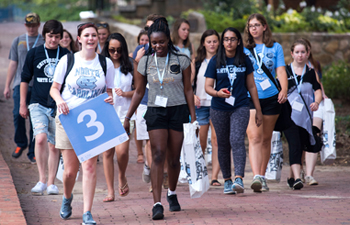Photography
Overview
Photography is one of the best tools to communicate a sense of place. It often creates the first impression with its visual presence. Thoughtful and carefully chosen photography can transform a marketing piece and can become an effective way to communicate about Carolina.
It is important to use professional photography in University materials whenever possible. For help coordinating a photo shoot, connecting with a freelancer or consulting about any projects or workshops, contact Amanda Zettervall, director of visual communications and production, at azettervall@unc.edu.
Featured Photos
Tone and Mood for University Photography
Photography should display the diversity of interests and activities at the University. It should vary in place and subject matter and should reinforce Carolina’s friendly, open culture and academic excellence.
To capture the right tone and mood in your materials, please keep these guidelines in mind:
Photographs of people should most often be candid. Captured moments help viewers get an inside glimpse of Carolina, inviting them to be a part of the community.



To convey a sense of vitality and academic rigor, imagery should show activity and intellectual pursuit. It’s best to avoid passive shots.



Balance shots of individuals with ones that include more than one person in order to show a culture of collaboration.


Represent racial, gender, age and professional diversity.



Profile photographs and portraits of individuals should be friendly and approachable.



Use a variety of close-ups and wide shots. Close-ups create warmth and familiarity, while wide shots convey expansiveness.


Landmark images are most valuable when they also feature people and interaction. When using photos of the campus, architectural structures or interior shots, convey a sense of openness by lowering the horizon line or cropping images in a wide format.



Essential Foundations for a Great Photo
Great lighting can be created by setting up artificial lights or by utilizing the natural daylight—or a combination of both. It is best to avoid direct sunlight in order to reduce harsh shadows, particularly on faces.
Poor Lighting

Good Lighting

The rule of thirds is a compositional guideline for creating well-balanced photographs. Utilizing this rule adds visual interest to photographs by placing the subject matter in an area where the viewer’s eyes are naturally drawn. An example of the rule of thirds grid is illustrated below.
Rule of Thirds Grid

Example Using Rule of Thirds

When you have an opportunity for a great shot, it is a good idea to capture it both vertically and horizontally. This will ensure plenty of options later to use the image in places with different proportions and orientations.
The focus of a portrait should be on the subject. Try to avoid complicated lighting setups and backgrounds. Instead, err on the side of simplicity so that the image looks as natural as possible.
Photography Resources
The Office of University Communications provides a photography and videography database in order to help enhance materials created for the University.
Please note that no image or video may be:
- Used for commercial or advertising purposes without written permission from the University of North Carolina at Chapel Hill.
- Altered from its original content without permission of the University of North Carolina at Chapel Hill.
- Used for endorsements, whether explicit or implied.
For more information, contact Jon Gardiner, University photographer, at jon.gardiner@unc.edu.
For photos and videos used for fundraising or advancement, please contact Jeyhoun Allebaugh in the Office of University Development at jeyhoun@unc.edu or 919-597-0797 for consultation or access to a selection of appropriate images and footage.
Consent Guidelines
A release is needed in the following situations:
- When asking people to engage in an activity in which they are not otherwise participating
- When photographing students in a classroom or residence hall (or some other venue in which they might otherwise have an expectation of privacy) and their faces will be identifiable
- Anytime a minor is photographed (under the age of 18)
The University’s consent forms are available for download. When using the electronic consent form, please ensure the instructions listed on the first page of the PDF are followed.

